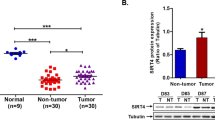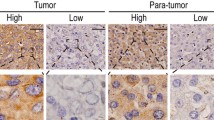Abstract
E2F-1 is a transcription factor involved in DNA synthesis and repair, cell proliferation, and apoptosis. Hyposphorylated pRb represses E2F-1 action in early G1 phase, while in late G1, pRb hyperphosphorylation leads to E2F-1 release and activation. In vitro studies have shown that E2F-1 may act either as oncogene or as tumor suppressor gene. We evaluated immunohistochemical expression of E2F-1 protein in chronic viral liver disease and hepatocellular carcinoma (HCC) and correlated this with clinicopathological parameters, cell proliferation, apoptosis, and the expression of E2F-1-regulators, pRb, and phospho-pRb (Ser795). In liver biopsies from 30 patients with chronic viral hepatitis, including 22 with cirrhosis without HCC, and 57 with cirrhosis with HCC, E2F-1 expression was assessed by immunohistochemistry. In chronic hepatitis and cirrhosis, hepatocytes and cholangiocytes demonstrated mild cytoplasmic and/or nuclear membrane E2F-1 immunostaining. In contrast, all HCC (100 %) showed strong nuclear E2F-1 immunostaining, with or without membrane accentuation, while a minority demonstrated additional moderate cytoplasmic immunostaining. Abnormally low pRb and phospho-pRb expression was seen in 70 % and 67.9 % of HCC, respectively. In HCC, nuclear E2F-1 expression was inversely correlated with phospho-pRb expression (p = 0.001) and positively related to tumor apoptotic index (p = 0.025). No significant correlation was found between E2F-1 expression and patient demographics, HCC etiology, tumor grade, pRb, p53 expression, or cell proliferation. In conclusion, we show that the increased expression of E2F-1 protein in human HCC is correlated with enhanced tumor cell apoptosis supporting a pro-apoptotic role of E2F-1 in human HCC.



Similar content being viewed by others
References
Parkin DM, Bray F, Ferlay J, Pisani P (2005) Global cancer statistics, 2002. CA Cancer J Clin 55(2):74–108
Ferlay J, Shin HR, Bray F, Forman D, Mathers C, Parkin DM (2010) Estimates of worldwide burden of cancer in 2008: GLOBOCAN 2008. Int J Cancer 127:2893–2917. doi:10.1002/ijc.25516
Tan A, Yeh SH, Liu CJ, Cheung C, Chen PJ (2008) Viral hepatocarcinogenesis: from infection to cancer. Liver Int 28:175–188. doi:10.1111/j.1478-3231.2007.01652.x
Wong CM, Ng IOL (2008) Molecular pathogenesis of hepatocellular carcinoma. Liver Int 28:160–174. doi:10.1111/j.1478-3231.2007.01637.x
Hallstrom TC, Nevins JR (2009) Balancing the decision of cell proliferation and cell fate. Cell Cycle 15:532–535. doi:10.4161/cc.8.4.7609
Tsantoulis PK, Gorgoulis VG (2005) Involvement of E2F transcription factor family in cancer. Eur J Cancer 41:2403–2414. doi:10.1016/j.ejca.2005.08.005
Polager S, Ginsberg D (2008) E2F—at the crossroads of life and death. Trends Cell Biol 18:528–536. doi:10.1016/j.tcb.2008.08.003
Gorgoulis VG, Zacharatos P, Mariatos M et al (2002) Transcription factor E2F-1 acts as a growth-promoting factor and is associated with adverse prognosis in non-small cell lung carcinoma. J Pathol 198:142–156. doi:10.1002/path.1121
Zacharatos P, Kotsinas A, Evangelou K et al (2004) Distinct expression patterns of the transcription factor E2F-1 in relation to tumour growth parameters in common human carcinomas. J Pathol 203:744–753. doi:10.1002/path.1582
Conner AE, Lemmer RE, Omori M et al (2000) Dual functions of E2F-1 in a transgenic mouse model of liver carcinogenesis. Oncogene 19:5054–5562
Ladu S, Cabisi DF, Conner EA, Farina M, Factor VM, Thorgeirsson SS (2008) E2F1 inhibits c-Myc driven apoptosis via PIK3CA/Akt/mTOR and COX-2 in a mouse model of human liver cancer. Gastroenterology 135:1322–1332. doi:10.1053/j.gastro.2008.07.012
Nakajima T, Yasui K, Zen K et al (2008) Activation of B-Myb by E2F1 in hepatocellular carcinoma. Hepatol Res 38:886–895. doi:10.1111/j.1872-034X.2008.00324.x
Huynh H, Do PT, Nguyen TH et al (2004) (2004) Extracellular signal-regulated kinase induces cyclin D1 and Cdk-2 expression and phosphorylation of retinoblastoma in hepatocellular carcinoma. Int J Oncol 25:1839–1847
Anthony PP, Ishak K, Nayak NC (1978) The morphology of cirrhosis. J Clin Pathol 31:395–414
Bosman TF, Carneiro F, Hruban HR, Theise DN (2010) WHO classification of tumours of the digestive system. IARC Press, Lyon, pp 205–216
Ishak K, Baptista A, Bianchi L, Callea F (1995) Histological grading and staging of chronic hepatitis. J Hepatol 22:696–699
Ishak KG, Goodman ZD, Stocker JT (2001) Tumors of the liver and intrahepatic bile ducts. In: Atlas of tumor pathology, 3rd series, Fascicle 31. AFIP, Washington, DC, pp 219–220
Koskinas J, Petraki K, Kavantzas N et al (2005) Hepatic expression of the proliferative marker Ki67 and p53 protein in HBV or HCV cirrhosis in relation to dysplastic liver cell changes and hepatocellular carcinoma. J Viral Hepat 12:635–641. doi:10.1111/j.1365-2893.2005.00635.x
Roesch A, Becker B, Meyer S et al (2005) Overexpression and hyperphosphorylation of retinoblastoma protein in the progression of malignant melanoma. Mod Pathol 18:565–572. doi:10.1038/modpathol.3800324
Yamazaki M, Hasegawa M, Ohaka I et al (2005) Increased E2F-1 expression via tumour cell proliferation and decreased apoptosis are correlated with adverse prognosis in patients with squamous cell carcinoma of the oesophagus. J Clin Pathol 58:904–910
Yamazaki K, Yajima T, Nagao T (2003) Expression of transcription factor E2F-1 in pancreatic ductal carcinoma: an immunohistochemical study. Pathol Res Pract 199:23–28
Suh DS, Yoon MS, Choi KU, Kim JY (2008) Significance of E2F-1 overexpression in epithelial ovarian cancer. Int J Gynecol Cancer 18:492–498
Evangelou K, Kotsinas A, Mariolis-Sapsakos T et al (2008) E2F-1 overexpression correlates with decreased proliferation and better prognosis in adenocarcinomas of Barrett oesophagus. J Clin Pathol 65:601–605
Liontos M, Niforou K, Velimezi G et al (2009) Modulation of the E2F1-driven cancer cell fate by DNA damage response machinery and potential E2F1 targets in osteosarcoma. Am J Pathol 175:376–391. doi:10.2353/ajpath.2009.081160
Grassi A, Susca M, Ferri S et al (2004) Detection of the M30 neoepitope as a new tool to quantify liver apoptosis. Am J Clin Pathol 121:211–219. doi:10.1309/UK621LFJ4FX07KDE
Iwamoto M, Benerjee D, Menon LG et al (2004) Overexpression of the E2F-1 in lung and liver metastasis of human colon cancer is associated with gene amplification. Cancer Biol Ther 3:395–399. doi:10.4161/cbt.3.4.733
Azechi H, Nishida N, Fukuda Y et al (2001) Disruption of the p16/cyclin D1/retinoblastoma protein pathway in the majority of human hepatocellular carcinomas. Oncology 60:346–354. doi:10.1159/000058531
Liu K, Lei XZ, Zhao LS et al (2005) Tissue microarray for high-throughput analysis of gene expression profiles in hepatocellular carcinoma. World J Gastroenterol 11:1369–1372
Tan L, Fu X-Y, Liu S-Q et al (2005) Expression of p28GANK and its correlation with RB in human hepatocellular carcinoma. Liver Int 25:667–676. doi:10.1111/j.1478-3231.2005.01003.x
Wang WH, Hullinger RL, Andrisani OM (2008) Hepatitis B virus X protein via the p38MAPK pathway induces E2F1 release and ATR kinase activation mediating p53 apoptosis. J Biol Chem 283:25455–2567. doi:10.1074/jbc.M801934200
Machida K, Liu JC, McNamara G et al (2009) Hepatitis C virus causes uncoupling of mitotic checkpoint and chromosomal polyploidy through the Rb pathway. J Virol 83:12590–12600. doi:10.1128/JVI.02643-08
de la Luna S, Burden M, Lee C et al (1996) Nuclear accumulation of the E2F heterodimer regulated by subunit composition and alternative splicing of a nuclear localization signal. J Cell Sci 109:1717–1726
Roh V, Laemmle A, Von Holzen U et al (2008) Dual induction of PKR with E2F-1 and IFN-alpha to enhance gene therapy against hepatocellular carcinoma. Cancer Gene Ther 15:636–644. doi:10.1038/cgt.2008.34
Acknowledgments
We gratefully acknowledge the support of “Kapodistrias” Research Program, Special Accounts Research Fund 70/4/6549, National and Kapodistrian University of Athens (NKUoA), Greece. We thank Prof. V. Gorgoulis, Laboratory of Histology and Embryology, NKUoA, Greece for helpful insights, suggestions, and critical review of the manuscript and Dr. A. Kotsinas, Laboratory of Histology and Embryology, NKUoA, Greece, for his support during the experimental part of the study. The technical expertise of Ms. Kalliopi Apostolopoulou is appreciated.
Conflict of interest
None
Author information
Authors and Affiliations
Corresponding author
Additional information
M. Palaiologou, BSc, and Dr. J. Koskinas, MD, PhD, contributed equally to this work.
Rights and permissions
About this article
Cite this article
Palaiologou, M., Koskinas, J., Karanikolas, M. et al. E2F-1 is overexpressed and pro-apoptotic in human hepatocellular carcinoma. Virchows Arch 460, 439–446 (2012). https://doi.org/10.1007/s00428-012-1220-4
Received:
Revised:
Accepted:
Published:
Issue Date:
DOI: https://doi.org/10.1007/s00428-012-1220-4









